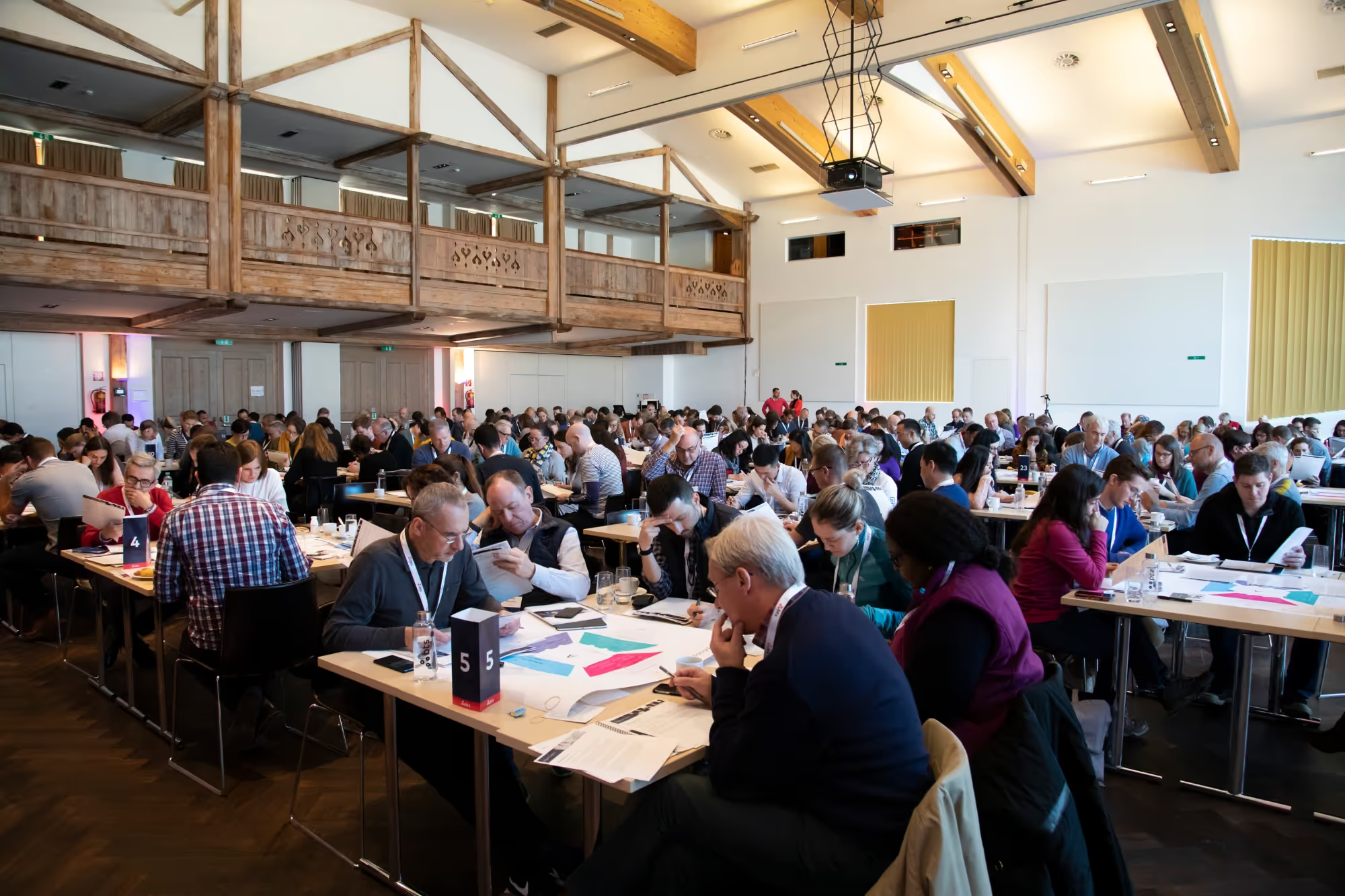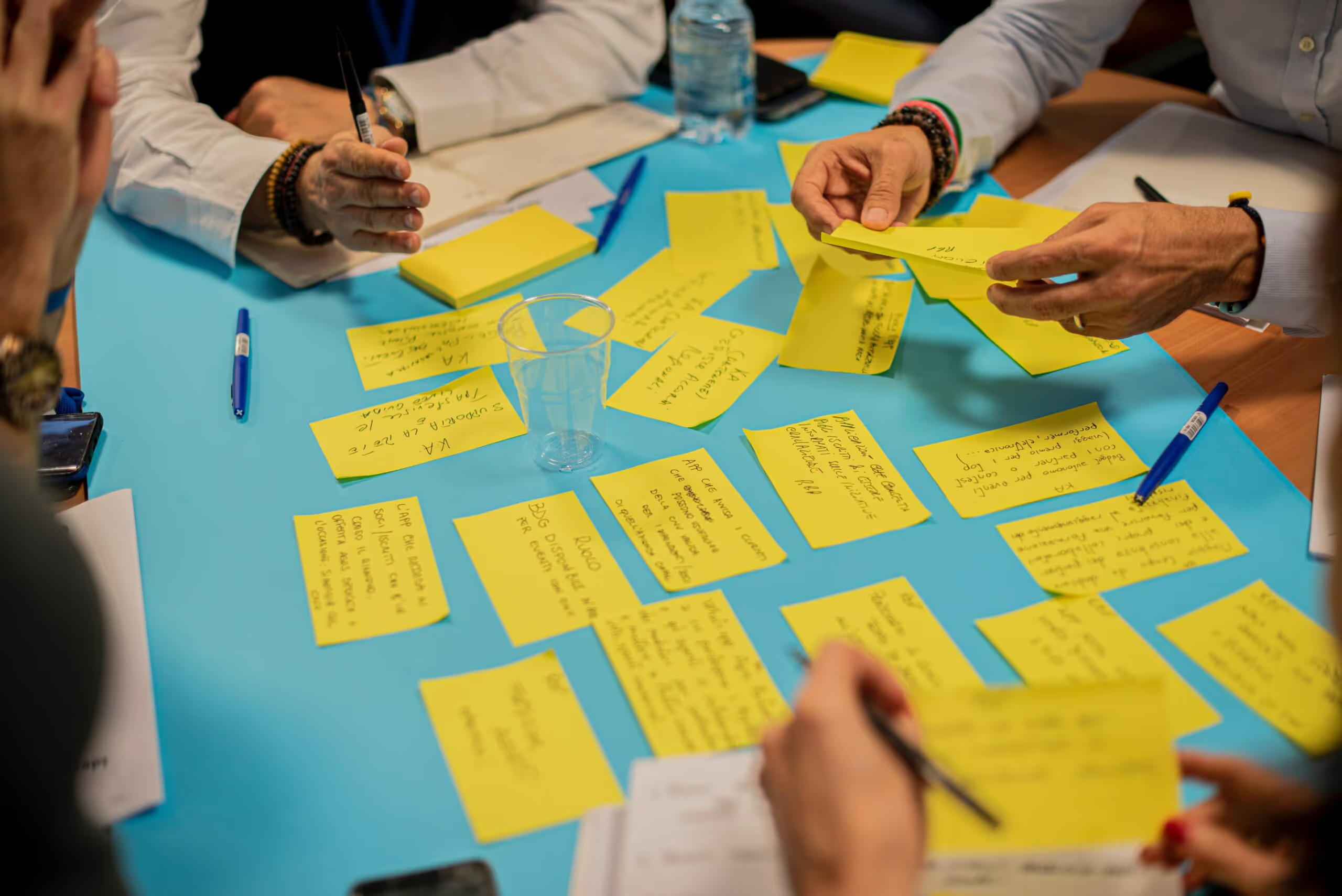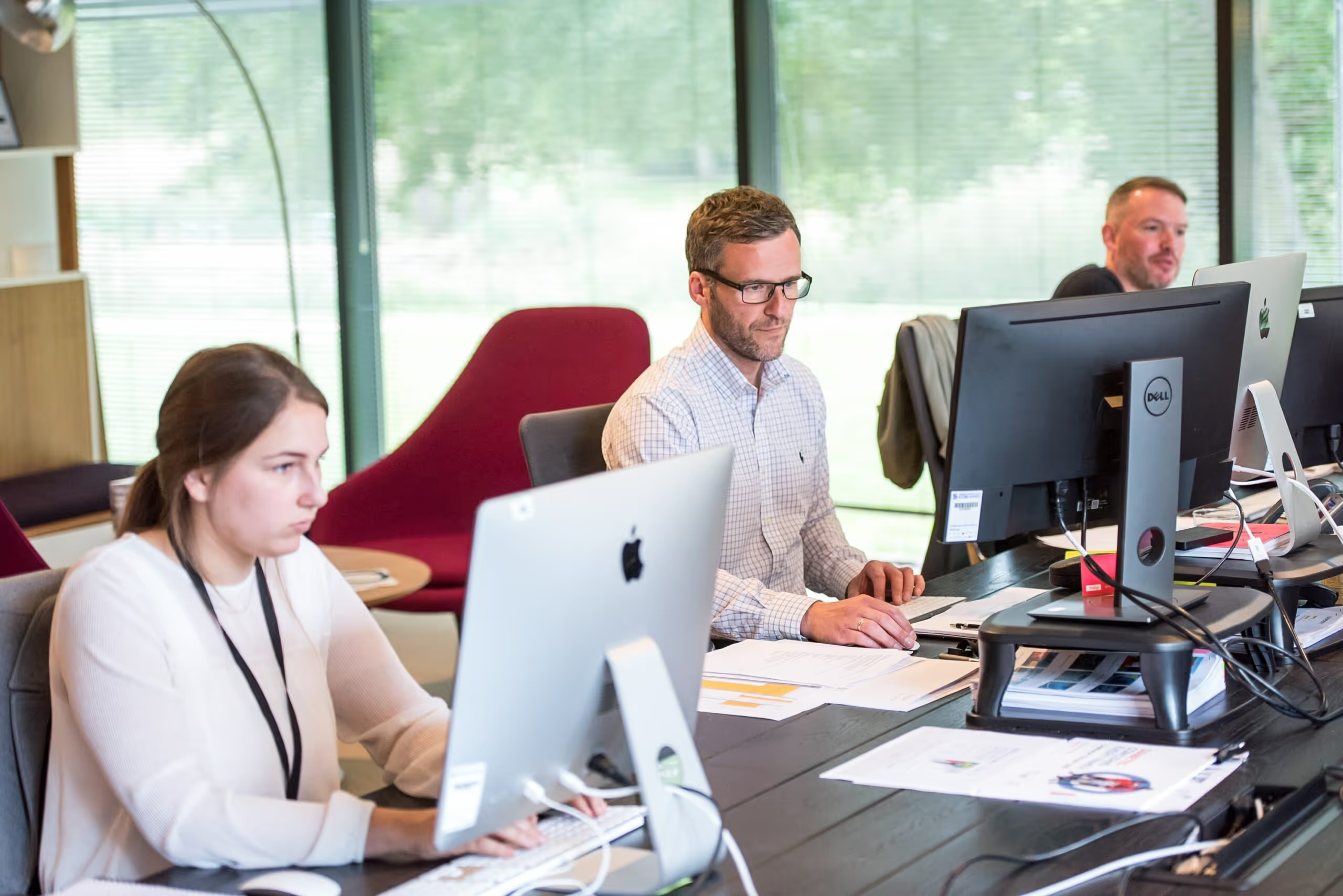Client Stories


Developing future-ready executive leaders
Client need
A multinational SaaS organization focused on search, observability, and security needed to scale following its initial public offering, but faced several obstacles.
The organization’s leaders needed to:
- Scale their go-to-market strategy to determine how to reach key client decision makers, build strong relationships, articulate the impact of their solutions, and prepare for the next phase of SaaS growth.
- Extend their product leadership by improving cloud platform accessibility, maintaining technology differentiation, and both protecting and evolving the company’s unique culture with every new hire.
- Adapt to a rapidly changing market by prioritizing activities which would enable the organization to stay ahead of its competitors, building stronger relationships internally, a distribution model externally, and expanding to new-use cases and larger deployments.
To meet these needs, the organization partnered with BTS to design an immersive learning journey that would challenge its next generation of executive leaders to define the organization’s next-chapter growth.
Solution
BTS deployed the resulting leadership development program for the organization’s leaders both virtually and in a hybrid setting over the course of four months.
The journey was designed to address the following five core themes:
- Being employee and customer centric: Recognize the changing needs of both employee and customer personas to drive value, while shifting to an outside-in, customer-centric mindset.
- The organization’s “North Star”: Ensure that all leaders understand and communicate the organization’s purpose and strategy well enough to inspire and empower their teams.
- Design for the future: Prioritize organizational growth over ten years’ time, not just two.
- Enterprise mindset: Eliminate siloed thinking to effectively collaborate across functions.
- Protect and evolve organizational culture: Nurture the best aspects of the existing culture while adapting to a changing context.
The development program consisted of three workshops:
- Driving the strategy (leading the organization): A customized business simulation in which leaders practice decision-making in realistic scenarios, addressing specific organizational challenges and objectives.
- Leading with purpose (leading self): Interactive peer coaching sessions to help leaders better appreciate their individual strengths, then leverage them while leading their teams.
- Change-ready leader (leading others): Further interactive peer coaching sessions designed to help leaders manage the uncertainty and resistance that comes with change.
Additionally, teams selected cross-functional business challenges to explore in greater detail, conducting interviews and analysis before presenting their findings to the CEO and executive team during a capstone session.
Results
So far, two cohorts have completed the leadership development program. At the capstone session, both the CEO and CHRO appreciated the breadth and depth of team insight and initiated several immediate, large-scale changes, including an update to the company’s leadership expectations and values.
The first cohort reported the following percentage improvement in scores that measure individual agreement with the following statements:
- +13: “I create alignment and clarity on direction among my team by connecting to our vision and strategy.”
- +19: “I make decisions that future-proof the organization by thinking and acting with scale in mind.”
- +20: “I drive functional interdependence between my team and those around me to collectively execute on our organizational objectives.”
- +16: “I have open and honest dialogue both downwards and upwards in service of nurturing our Source Code and growing each other, the business, and customers.”
- +11: “I foster a psychologically safe environment that enables experimentation, risk taking, and learning.”
- +19: “I step into the shoes of our customers to understand and empathize with their differing needs.”
- +13: “I lead customer centric conversations around enablers and barriers to customer success and satisfaction.”
The second cohort reported the following:
- 100% reported that “The program’s learning objectives related to my job.”
- 93% agreed that “My learning was enhanced by the work of the facilitator.”
- 100% reported that “My learning was enhanced by the work of the facilitator.”
- 88% agreed, “I will be able to immediately apply what I learned in my job.”
Participants rated the program 88 out of 100 when asked if they would recommend it.
Testimonials
“Explicit recognition of our strengths, values, and what drives us is a powerful tool I will carry forward."
“I love this concept of using the friction in change to spark debate [that enables us to] lead through the change.”

Reimagining an oil and gas organization’s business model for an energy transition
Client need
One of the world’s largest energy organizations needed to reimagine its business model in preparation for a future with limited oil and gas usage. The organization’s leadership team proposed shifts such as restructuring the business to explore future ideas, as well as hiring and upskilling people in order to bring those ideas to fruition.
However, the organization's leadership team found that one of the biggest challenges was helping people shift their mindsets about what the future of the industry might look like. To bring about these mindset shifts, the organization’s leaders partnered with BTS to develop an experience that would help their people gain a fresh perspective on the industry.
The solution
BTS facilitators engaged the organization’s leaders in a leadership development program called the Disrupt Experience. In multiple simulation sessions lasting up to two days, cohorts of 15 – 125 high potential and new energy business unit leaders were “hired away” to a fictional company that 1) was equipped with different resources and capabilities and 2) planned to enter and disrupt the energy industry.
Throughout the Disrupt Experience:
- Participating leaders were “onboarded” to the fictional company. During this process, they received a guide called the Disruptor’s Playbook that offered tactics for competing with their previous organization and the disrupting industry at large.
- Next, they met with a potential customer whose aims included helping the province become greener, preserving jobs, investing in the energy industry, and even becoming prime minister. The participating leaders used the Disruptor’s Playbook to explore how they might help the customer achieve these aspirations. The Playbook consisted of five chapters: define strategic intent, discover customer problems, ideate, refine, and conduct disciplined experimentation.
Results
Throughout the simulation experience, the client’s leaders had to think ahead and imagine what their industry might look like, who their customers might be, and what efforts would be needed for success, building new skills with every challenge. Participating high potentials and new energy business unit leaders provided an average rating of 8.7 out of 10.
Ultimately, participants walked away with a fresh perspective on meeting their customers’ changing needs, as well as some practical first steps towards restructuring their business model. After experiencing four sessions to date, the organization’s leadership team has requested five more sessions in the year ahead to reach as many of its leaders as possible.
Testimonials
“Strength in numbers to implement this new way of thinking quickly — our company needs it!” - Maintenance and Reliability Manager
“Very enjoyable and thought-provoking.” - Business Development Analyst
“[The Disrupt Experience] opened my eyes to a new way of thinking.” - Geological and Geophysical Operations Team Leader

Develop global leader capability for mining company
Client need
Develop and deliver a global capability program that would enable leaders to make practical and measurable changes in:
- Build greater self-awareness and an understanding of the coach mindset
- Flex your coaching style to different people and conversations
- Make activities and leadership routines which rely on coaching skills more meaningful and engaging
- Empower others to commit to and solve their own problems
- Use everyday conversations to embed our values and behaviours
The solution
The learning and application was staggered with 90-minute learning bursts across a 6-week period. This gave the participants an opportunity to experiment learning between sessions.Sessions were structured with small groups which serves as a platform to share and discuss challenges with peers, while guided by a professional coach.As the learning was not location bound, this provided participants with the opportunity to share learning and network across diverse regions and functions
Results
Over 20 Pod group sessions with over 150 leaders during a 6-week journey.Participants outcomes:
- 9.1 out of 10 for overall Leader as Coach experience
- 9 out of 10 likely to recommend experience
- 8.9 out of 10 found the group Pod sessions to be interactive and engaging
“The facilitator made everyone comfortable to share and engage. The responsibility on performing better as a coach immediately on the individual which makes you feel more engaged. No one will do it for you.”
“Loved the interaction and openness. The facilitator was wonderful and really engaging, which I find makes my experience very real and valuable. Love the varying levels of attendees also as offers a diverse perspective”.

Developing future-focused leaders to drive smart growth
Client need
A $6 billion federal contracting company in the U.S. needed to build a future-focused leadership bench capable of executing its strategy to deliver on growth and extend their position of industry leadership. While the company has a successful history, they recognized an opportunity to invest in critical capabilities that would ensure their continued success in a rapidly changing environment. The CEO and the leadership team were looking for an innovative approach to accelerate their leaders’ ability to lead and influence others, while simultaneously strengthen their capabilities to make data-driven decisions in critical moments.
The development journey they took with BTS began by grounding these high potential leaders in the capabilities and behaviors that create executive presence and influence as measured by the Bates ExPITM leadership model, while connecting it to the business-critical themes of strategic thinking, entrepreneurial thinking, and innovation. The Leader Lab integrated experience enabled their leaders to develop and practice strategy execution, while flexing key elements of executive presence. As the leaders worked through the journey together, they were able to practice collective leadership based on collaboration and trust, a key goal for the enterprise.
The solution
The development journey was spread over two dynamic and fast-paced development sessions. The audience was 50+ high-potential and cross-functional leaders, who manage some of the company’s largest, multi-million-dollar client relationships.
Building the capabilities of executive presence
Participants started by going through the ExPITM assessment, combined with virtual coaching calls and debriefs, to understand their strengths and opportunities to lead effectively. They then attended a 3-day classroom-based program. The first two days focused on strategy, entrepreneurship, and innovation, taught by a local university’s business program. On day three, BTS facilitators highlighted behavioral elements of leadership presence and influence. Post-program the leaders took the practical, tangible learnings back to practice in the business and build their skills.
Leader Lab: tapping the power of business acumen
In the next phase of the learning journey, participants attended a live, classroom-based Leader Lab. This customized experience included a three-day business simulation. Together in teams, leaders assumed different positions from their day-to-day roles, grappling with tradeoffs similar to those they would encounter in real life and practicing making decisions in a safe learning environment. This experience was designed to inspire leaders to adopt enterprise-wide thinking and strengthen their decision-making capabilities. The Leader Lab experience included:
- Two rounds of simulation dedicated to executing their team’s strategy by running their ‘business’ in a dynamic market where unexpected moments force the team to make quick decisions.
- Observation-based assessment of individuals on each team, based on behaviors core to executive presence and communication
- Introduction to an intuitive yet powerful approach for applying data-driven decision making
- Practice delivering persuasive presentations in small groups with peer and expert feedback
To reinforce behavioral change resulting from the sessions, participating executives committed to simple actions that would facilitate accountability and help leaders carry learnings back to their teams. Facilitators continuously provided feedback, encouraging leaders to collaborate across the enterprise and invest more time in getting to know one another.
Results
The collaborative spirit generated in the session was highly visible and contagious – just the kind of mindset and energy the company needed to move its culture forward to achieve new growth. Both sessions were ranked highly by participants, garnering a Net Promoter Score (NPS) of 82 and 93, respectively.
Following these development efforts, the company’s high potential leaders advanced their ability to work together more collaboratively, and problem solve at a peer level, reducing the need to escalate issues and increasing the speed of execution. This is reducing risk and increasing work efficiency. It has also improved their ability to lead and manage their multi-million dollar-client portfolios as they apply their new leadership skills with their teams and their client partners, reinforcing the longer-term sustainability of that revenue.

Developing future talent for global mining company
Client need
Developing future talent to lead the future of the organisation, customer centricity, changing behaviours to match values, and needing leaders to drive better results.
The solution
- Mapping of the organization’s leadership capabilities and values to BTS Coach mindset shifts for greater alignment to business goals
- Utilizing a range of core and custom designed programs targeting the development of future leaders and coaching high potentials
- Inclusion of Leader as Coach as core leadership program as well as development of bespoke mindset programs for specific teams and functions
Results
Benefit areas:
- Increased efficiency and quality
- Retention of leaderhip talent
- Strategic effectiveness
- Improved collaboration
More than 1,300 individual coaching journeys, with 97% stating they would recommend coaching to a colleague. And 96% experience significant or some change as a result of their coaching.
“The coaching has enabled me to improve on several aspects of my leadership. Some simple changes to my mindset has had an impact on how I execute my work and perceive challenges in the workplace.”
“The personal reflection on my own coaching style has been profound, in particular, the learnings to pause, and ask effective questions, rather than feeling as though I have to solve rapidly.”

Driving sales transformation through enabling relationship managers
Client need
One of the segments within a leading bank was undergoing significant structural change. As a result, the segment needed to transform its salesforce and redefine its value proposition.
The organization targeted its relationship managers for the intervention. It sought to create a different kind of relationship manager – one that would enable the organization’s strategic vision by both thinking differently about the role and applying a different approach to internal collaboration and sales processes.
The organization selected BTS as a partner in building the right processes, tools, and capabilities to enable its relationship managers to be successful. The organization’s Head of Sales and Head of the Business Unit served as executive sponsors for the initiative, ensuring buy-in from stakeholders and providing support.
Solution
The transformation would reach 450 relationship managers from business units across the bank, spanning 11 countries. To reach this broad audience, the organization needed a scalable, virtually accessible solution.
To enable this shift, BTS created a learning journey using its proprietary GREAT framework. The content was developed through an iterative process and a partnership between BTS and a steering committee made up of stakeholders from the organization. This ensured that the tools, process, and methods were completely aligned to the context of the relationship manager and organization.
To kick off the journey, BTS and the organization hosted structured sessions with executives, sales leadership, and clients to determine the top characteristics that a relationship manager within the organization would be expected to display:
- Client acumen: Focuses on client knowledge, insights, and how to leverage them to create solutions that help clients achieve their financial priorities.
- Professional: Focuses on how to “show up” during face-to-face and virtual client engagements. Demonstrates the ability to convey executive presence through a thorough understanding of the client and the bank.
- Business acumen: Understands the bank’s financials and their role in impacting its overall performance.
- Innovative: Innovates when solutioning a client, and creates memorable client experiences.
- Solution focused: Focuses on the solution instead of the sale. Holistically creates solutions with the client, as opposed to selling products.
- Digitally savvy: Understands a digital-first approach and leverages various digital tools to create memorable client experiences.
- High level of urgency: Fosters a mindset of urgency in all matters relating to the client and bank.
These capabilities translated to the following behaviors for relationship managers, which became the red thread connecting all elements within the journey:
- Manage themselves and deliver results.
- Leverage data to create a memorable client experience.
- Use the right tools to add value to sales conversations, by 1) leveraging new language, and 2) providing the correct solution to improve the client’s financial well-being.
- Develop a deep understanding of — and how relationship managers can impact and influence — the client’s strategy, which is focused on outcomes.
- Use the CRM to guide client-related decision making and apply focused execution.
- Act with a high degree of urgency, communicate with a regular cadence, and be highly productive in client-facing situations.
To create the solution, BTS and the organization leveraged the following design principles:
- Workshops run in the flow of work, so as not to negatively impact the number of relationship managers’ selling hours.
- Content is both impactful yet practical so that tools and principles can be applied immediately after attending the workshop.
- Workshops are interactive, featuring a discovery-learning approach that encourages interaction across regions and countries.
- The journey spans enough time to provide opportunities for application and feedback.
With these in mind, the relationship manager journey was born. Over a three-month period, relationship managers would attend six sessions per month, each of which lasted two hours. Prior to beginning the journey, participants would go through an assessment that would allow the organization to benchmark progress against an assessment taken after program completion.
The solution centered on a customized simulation that addressed the following eight critical moments. These moments provided relationship managers with the opportunity to practice new behaviors in risk-free situations modeled after those experienced on the job. If mastered, performing in these moments would allow relationship managers to add the most value to the bank and its clients:
- Planning, looking at trends impacting clients, targets, collaboration, and sales plays
- Prioritizing:
- Operational cadence
- Types of opportunities
- Preparing for and conducting sales calls in a virtual or face-to-face setting
- Conducting discovery conversations under time constraints
- Preparing for and pitching to a client
- Handling objections
- Preparing for and conducting sales calls in a cross-functional team
Following each workshop, relationship managers complete two Go-Do activities, which are actions to be taken back on-the-job to reinforce learning. These are designed to be completed the same day as the workshop and tracked in the organization’s CRM. This enables the organization to not only track the application of learning activities, but also drive adoption of the tool.
Due to participants’ geographical spread, each country unit was informed of the transformation and the changes that would occur. The organization’s leadership requested that each unit not only prioritize activities related to the journey, but also application of lessons learned.
In addition to the relationship-manager journey, the organization’s sales leaders were also taken through a journey of their own that equipped them with new techniques to coach and guide relationship managers. During this experience, the executive sponsor engaged with each sales leader on a regular basis to provide support.
Integrating a series of coaching experiences for the sales leadership team ensured that they were equipped to effectively support the relationship managers during their journey. Leaders received coaching guidelines for each module of the learning journey to ensure that they provided their teams with a consistent approach. This coaching journey was also tracked in the organization’s CRM to both embed the value of CRM use and track any application of the coaching.
Results
As a result of the program, the organization achieved the following results:
- Workshop elements
- Net Promoter Score of 85
- Facilitator Score of 9.3/10
- Impact on confidence: A majority of relationship managers showed continuous increases in confidence against the learning outcomes.
- Behavior shifts
- Learners had committed to almost 1,000 activities.
- 52% of these activities were on track or completed.
- The remaining 48% have yet to be completed or are scheduled to be completed later.
- Business Results
- Increases across all KPIs
- Average of 80 new customers per relationship manager over a six-month period
- Relationship managers who had been through the program won twice as much new business as their colleagues who had not.
- Global Awards
- Awarded a silver Brandon Hall award for sales performance

Building relationships to win in a competitive market
Client need
A multi-billion-dollar multinational electronics organization had experienced strong and steady growth for years. To maintain this trajectory through increased competition and shifting customer demands, the organization needed a new marketing framework dedicated to customer-oriented results by execution.To implement this strategy, the organization partnered with BTS to co-create a training program for its visual display division’s B2B business development teams called “Winning in the competitive market.” The two-fold solution would help salespeople and marketers 1) build long-term customer relationships and 2) strengthen collaboration between teammates based out of the organization’s headquarters and their counterparts at regional offices. By deepening their understanding of each, the organization’s sales and marketing teams would translate the new marketing framework into action across the globe.
The solution
Creating skills and behavior change
The resulting three-day program was rolled out to global sales and marketing managers through a mixture of virtual and in-person deliveries, as well as facilitator-led and self-paced learning. The program included a business-analysis simulation that allowed salespeople and marketers to test and understand the implications of the new marketing framework in a risk-free environment. The simulation built new skills and behaviors through:
- Defining critical moments throughout the sales process, such as negotiating prices within a strategic account
- A playbook with great (and not-so-great sales) tactics for addressing critical moments
- Innovation and digital transformation future-storming
At each decision-making juncture, sales and marketing managers came to understand the larger business development environment, the specific role of sales, and streamlined ways of working between their headquarters and regional offices — all with the goal of winning in an ever-competitive market.
Conclusion and results
Three years into the program, the organization has expressed its satisfaction with an NPS of 4.8.Progress on Go-Dos, or specific actions to be taken back on the job, is as follows:
- 48% of managers have finished the program
- 48% are in progress
- 4% have yet to begin
Testimonials
“The simulation was great and encouraged collaboration and engagement from the whole group.”
“The facilitators had strong knowledge of the business, and examples were real and current.”

Global mining graduate development program
Client need
A global metals and mining organisation sought a partner in enabling new graduates successfully transition into corporate life. Such a program would help recent graduates examine the organisation’s culture, determine whether their own behaviours and values would mesh with it, and adjust accordingly.
The solution
The organisation partnered with BTS to co-create the Global Graduate Excellence Program, streamlining new graduates’ transition to and development at the organisation. Over a two-year span, the program:
- Explored the organisation’s unspoken 'rules' which made the difference between success and failure.
- Enabled participants to identify that which limited their potential.
- Provided the skills and tools these new graduates needed as a foundation for a promising career.
The program contained experiences that helped disrupt and shift the graduates’ mindsets, including:
- Virtual, personalised 1:1 coaching on topics such as employee engagement, building commitment and support, influencing, personal authority, speaking up, and challenging the status quo.
- Virtual webinars allowing graduates to experiment, collaborate, and role-play with a small group of peers, covering topics such as transitioning into the organisation, creating a personal brand, and building the future.
- A Graduate Summit about supporting development through personal resilience, giving and receiving feedback, and collaboration; the summit integrated the entire journey with a celebration of achievements
These experiences combined all the mindsets and behaviors that were essential to establishing the right habits for recent graduates.
Results
BTS has delivered the Graduate Development Program to 549 graduates across five summits, 110 webinars, and 2,496 coaching sessions. Following program completion, the organisation found:
- Increases in efficiency (40%), quality (17%), and retention of leadership talent (11%).
- That 97% of graduates reported experiencing change (51% experienced significant change), shifts in self-confidence (72%), forming productive relationships with people, action-orientation, and decision making.
- 98% of participants felt that the program met their expectations (exceeded expectations for 60%), and 92% met the program objectives (45% exceeded their objectives set).
- That 97% of participants would recommend the 1:1 coaching, and 94% would recommend the Summit experiences.
Participant testimonials
"I have developed deeper relationships with my peers and leaders. This has improved teamwork/ morale and lead to better efficiency for both myself, my team, and the company.""The value that I have gained from the program has been enormous. I have been able to target development of key skills that were important to me, of which have significantly improved my personal and professional levels in the workplace."
“The value that I have gained from the program has been enormous. I have been able to target development of key skills that were important to me, of which have significantly improved my personal and professional levels in the workplace.”

Transforming organizational culture by developing new graduates
Client need
A leading global mining organization has embarked on a cultural transformation since its founding. Its leaders remain committed to offsetting negative effects caused by past operations, and — in light of recent costly accidents — to building a culture of safety, reliability, and sustainability.The organization’s leaders identified two needs: firstly, to boost its skilled talent pipeline by recruiting from a generation generally disinclined to work for organizations with heavy social and environmental footprints; and secondly, to identify and invest in its existing high potential talent, preparing such individuals to take on strategic roles in the future.To sustain its reputation as a talent-driven organization, the company partnered with BTS to design an effective horizontal and vertical development program for new graduates.
Solution
The resulting development journey was created by over 80 HR, learning, and talent professionals and 10 subject matter experts. Over the course of 18 months, it reached 172 individuals across the globe.The development journey included two “itineraries”: one for 55 global trainees, that focused on unearthing the organization’s business and administration functions, strategic initiatives, and HR processes; and another for specialist trainees, all about leveraging technical mining-related and logistical knowledge. Each itinerary featured three major pillars: soft skill development, hard skill development, and practical learning.
Soft skill development
Throughout this portion of the development program, which applied to both global and specialist trainees, BTS facilitators:
- Defined “Great” behaviors through robust data collection and interviews
- Created “Great Profiles,” or competency models that differentiate between “Great” and “Not yet great” behaviors throughout eight to ten critical moments that people experience on the job (for example, “When you do not have enough knowledge,” or “When presenting to other stakeholders”)
- Assessed participants using digitally-deployed “Moments Based Assessments” wherein participants made critical decisions in a simulated environment
- Focused on developing emotional intelligence through self-awareness, self-management, social awareness, and relationship management.
Hard skill development
This portion of the development program, which applied only to global trainees, was a virtual workshop that involved:
- An asynchronous financial course called Know the Business, which covered financial reporting, income statement and balance sheet interpretation, cash flow statements, financial relationships, and key ratio analysis.
- A fully customized business simulation designed to develop deep understanding of the mining industry. Participants experimented with four business units: corporate, iron ore, base metals, and coal.
Practical learning
This portion of the learning program applied to both specialist and global trainees.
Specialist trainees completed of a six month-long technical project:
- Specialists received support from senior leaders in their topic of choice. Their research culminated in a one-hour presentation for a board of managers and peers to which the CEO and VPs were invited.
- Presenting specialists learned how to use storytelling techniques, illustration, and imagery to amplify their findings.
Global trainees completed a seven month-long innovation project that leveraged Agile methodologies:
- Trainees began by consulting with senior stakeholders to identify opportunities for innovation within the organization’s strategy.
- After breaking into cross-functional groups, trainees refined their ideas through a series of learning modules and coaching sessions designed to help them overcome barriers to innovation and project management.
- Trainees also communicated their work through a polished executive presentation.
Results
- Both itineraries were evaluated using the Kirkpatrick Model to gauge effectiveness.
- Participating trainees expressed both a NPS of 71.5 and a satisfaction score of 9.16/10.
- When asked to rate their knowledge before and after the session, participants reported a “knowledge change” of 92.7%.
- Average attendance was 83.99%, reaching up to 94.44%.
The new graduates’ development program fostered trainees’ emotional intelligence, acumen, sense of innovation, and project management capability, all of which left a tangible impact on the organization’s reputation, talent pipeline, and succession plan. Due to its resounding success, the program is running for the second year, and the third one is currently being planned.

Evolving commercial capabilities following an acquisition
Client need
A German-based Crop Science organization needed to implement changes to its commercial strategy following an acquisition of another agricultural organization.
The newly combined organization’s overall goal of providing the best possible customer experience remained the same; but with an enlarged portfolio, changing organizational structures, and new strategic processes to implement, its people required additional support to execute strategic change.
The organization’s leadership team had previously partnered with BTS to build commercial capabilities in its people through in-person learning programs. Now, post-acquisition, the organization’s change and transformation teams needed to intensify the global reach of its learning programs and redefine commercial capabilities for a new era, but in a manner that remained relevant to individuals at every level and locale. Thus, the organization continued its partnership with BTS by designing a new digital learning solution for its commercial teams.
Solution
The organization’s change and transformation teams and BTS facilitators defined 22 new commercial capabilities, embedding them into a streamlined e-learning platform accessible by at least 7,800 people via their desktop and mobile devices.
These commercial capabilities — which comprised sales, marketing, and market development competencies — were region- and function-specific. They were also tailored to three types of learners: global and regional leadership teams, regional stakeholders, and end-users. The overall digital learning program intended to:
- Provide clear, role-specific expectations to each person
- Maximize customer value and success through efficient knowledge sharing
- Foster a culture of active, agile, and continuous up-skilling and development
Individuals built capabilities by progressing through the following pages on the platform:
- Commercial capability frame: Tutorials, platform information, and general tips.
- My learning journey – status: A hub for progress reports.
- My selected function/archetype: Specifying one’s role through the following sub-pages.
- Self-assess your level: Identifying current proficiencies.
- My learning journey: A personalized sampling of development content.
- Competencies for my function/archetype: Additional topics recommended for those in a specific role.
- Commercial fundamentals and Content recommended to me: Additional topics recommended for all people in the organization.
BTS facilitators collaborated closely with the organization’s cultural change and transformation teams to deploy the digital learning program in a very short timeframe.
Results
So far, measurement has consisted of collecting information about the individuals who participated in the learning program. The learning program has ultimately reached over 15,000 individuals, 50.98% of whom logged in from EMEA, 18.69% from NAFTA, 16.78% from LATAM, and 13.54% from APAC. Currently, facilitators are measuring progress according to The Kirkpatrick Model of Four Levels of Learning Evaluation, and have also recorded the following measures of learning engagement:
- 13,000 performance searches
- 310,395 total clicks
- 3,316 program downloads
- An average session duration of 7.3 minutes
The facilitation team is continuously improving the e-learning platform with new content topics and essential features that learners can access in increasingly convenient ways.

Mining Leaders Business Simulation
Solution overview
An Australian-based, global gold mining company engaged in a learning journey for their leaders. The four-day workshop was designed to help leaders Lead self, Lead team, and Lead business, by living organisational and personal values. The learning journey was designed to challenge the leaders in identifying who they are as leaders and how they show up. The company designed and delivered the first two components, Lead self and Lead team, as a separate two-day workshop. They then partnered with BTS to design and develop a business simulation for the Lead business component, and a program that connected to the Lead self and Lead team components. Their aim was to focus on the core types of decisions made by the executive committee and developed the following specific learning objectives:
- Demonstrate importance of connection between safety and performance
- Highlight the importance of ethical leadership through values
- Build business acumen – an appreciation of the value chain of the business, and the key elements and trade-offs of how their business operates
- Show how strategic initiatives create value for the organisation, and specifically link to their current strategic pillars and aspirations
- Understand the implications of market changes on decision making
- Show the value of each of the participants roles as leaders
One of the core learnings that came from the development of the business simulation, was how vital the role of values plays in decision making at the company. Following the pilot, a component was added to create a greater emphasis on teams defining their values in the strategy planning session, and then debriefing these throughout the day through the feedback rounds.The separate two-day Leading business workshop enabled participants to collaboratively make team decisions and compete against each other on key financial and non-financial metrics. Teams articulated and pursued their own strategy and had constrained resources to invest at each stage of the value chain. Below are stage outcomes of the value chain and questions highlighting those key trade-offs.
"Safety is a key priority at Newcrest, and was present at all levels of the value chain."
Results
The customised business simulation provided an opportunity for leaders to assume the role of the Executive Committee in a highly experiential and risk free environment. They built fundamental capabilities and practiced real-world decision making, as they brought to life the challenges of linking decisions to values whilst balancing the trade-offs of expansion, potential divestment of assets, growth and profitability; whilst ensuring safety was always paramount. To maximise their performance, the leaders could also bring the learnings from the Lead self and Lead team components of the journey into the business simulation conversations. They were then provided with feedback and analysis of their decisions and strategies to apply to their action plans back on the job.

Evolving an old culture to deliver on a next gen strategy
Client need
The CEO of a $10B life insurance company realized that despite steady growth, industry disruptions could create headwinds for their longer-term growth if they didn’t develop a stronger strategic position. Their next generation strategy focused on targeting a larger addressable market and reimagining how they provided value to customers in their ecosystem. This was a departure from their roots in selling life insurance, and required the organization to innovate and shift focus towards the customer.
At its core, the evolved strategy was a transition from a product-driven to a purpose-driven organization. As they began this transformation, the purpose and strategy weren’t adopted as quickly as they’d hoped. Through further examination, they uncovered resistance across the organization. It became clear that they did not have the right tenets in place for people to understand how to shift their behaviors. Employees did not understand the implications of this evolution, and thus it was left unadopted into daily roles. Interpretations of the new purpose varied. Employees were unclear on which actions to take. This was stymying their ability to get work done and collaborate effectively across silos. Stalled in their progress, they turned to BTS to help them make this critical culture change shift real.
Solution
The solution was multi-phased. BTS partnered with the client on a series of engagement sessions. We started by building their understanding of what it means to be purpose-driven. We then assessed and re-articulated their 160-year-old values and culture to support their future direction. We concluded with a plan to activate the new values and culture.
Phase 1: Embedding the purpose statement
Over a three-month period, we worked with their top 250 leaders to help them to internalize the purpose and understand the critical shifts required to live it. We conducted a series of 90-minute engagement sessions to assess for change readiness and created a shared vision about what was possible for the organization in their new purpose. This enabled the leaders to translate the words on the page into tangible and real actions they would take to drive the new strategy forward.
Phase 2: Evolving the organization’s values and ways of working
In working with the top 250 leaders on embedding the purpose, it quickly became clear the company’s values and culture needed to evolve to support their future. They needed to understand:
-
- How their values and culture were being lived today across the organization
- What they wanted to preserve
- Where they needed to pivot to be fit for the future strategy
Given the breadth of change, they chose to engage the broader organization in a thoughtful conversation to build collective ownership. We partnered with them to co-create the next iteration of values that would transform the organization’s culture, through 3 key elements.
- Discovery and assessment to deeply understand the current state. This started with a review of the company’s current state culture and values. We gathered input on future state aspirations across the organization from leader interviews and a culture assessment. The outcome was a current state evaluation highlighting the biggest strength and risk factors in achieving the future vision. We drafted future state values and culture aspirations to take forward with the Executive Leadership Team.
- Values creation working sessions to pave the path to the evolved culture. This included two Executive Leadership Team working sessions. The first focused on pressure-testing the draft future state values and culture aspirations required to enable the new purpose and strategy. The second created alignment on the final set of values and the immediate actions to gain momentum.
- Values activation plan to make it real. This took the output from the working sessions to create a transformation plan to activate the values across the organization. The plan set the stage for Phase 3 to make the transformation real.
Phase 3: Activating the values with the executive leadership team
This phase enabled the leadership team – which was relatively new-to-role and looking to make a big impact – to finalize their unifying vision for the company’s future and determine together how they would model and activate the new values for their teams and the enterprise. This phase included 3 components.
- Executive Leadership Team assessment, with research-based leadership team diagnostic, reporting, debrief, and alignment session design
- Executive Leadership Team alignment session, in person 2-day working session to work through assessment results and build alignment on working model and next steps
- Individual executive advisory for Executive Leadership Team members to accelerate the application in the organization.
Conclusion and results
Strategic Acceleration
As a result of the work, the CEO and the Executive Leadership Team translated their purpose into action for the enterprise. This resulted in their ability to accelerate the execution of their initiatives to access and grow new addressable target markets. The team took focused action to collaborate on new “customer-first” initiatives, bringing expanded offerings and new innovations to their existing multi-million-dollar relationships. The momentum allowed them to successfully deliver on their supporting digital transformation to make their “customer-first” promise real in the eyes of their clients.
Alignment & Ownership
They have aligned on and published new values that create clarity on what is expected from all people in the organization to live the new purpose. Because they engaged the whole organization, they created excitement and broad-based buy-in. Teams now seek out ways to live the new values, and report that their teams and peers’ accountability for living the purpose in personal and team actions is notably increased.
Embedding Values into Leadership and Talent Lifecycle
To continue to make the culture change real, they have taken the alignment to the next level. They started to embed these values across the talent lifecycle to create the new behaviors in their performance management system. They linked those behaviors to the changes that will deliver on innovation, client-centricity, and new market growth that is core to the strategy. This is an organizational milestone in creating the talent they need to execute, now and longer term, on the new strategic direction.

A learning journey: Retaining women talent
Client Need
An American multinational food manufacturing company was struggling to retain its female employees. Attrition was high, primarily due to lack of development opportunities, underrepresentation of women in the workforce, and unconscious bias around talent designation. Thus, managers and executives needed to create an environment that better supported and championed their female talent.
The organization partnered with BTS to devise a learning journey aimed at strengthening the presence of female leaders and improving their career advancement opportunities.
Solution
The resulting learning journey spanned three months and consisted of multiple week-long small group coaching sessions and workshops. BTS helped facilitate three separate groups during the program, including 30 to 35 high-performing female employees, line managers, and executives. Participants used a platform called Momenta, a proprietary BTS tool, to access tasks specific to their development group.
High-performing employees participated in four discussion groups, which focused on:
1) 12 crucial habits that hold women back from getting to the next stage in their career.
2) Fundamental ways to approach different situations and relationships.
3) The organization’s outlook and how to connect with stakeholders.
4) A unique, winning formula for gathering support from their network.
Line managers participated in two discussions where they explored:
1) Factors that hold women back in the workplace and challenges specific to women at the company.
2) How to support other women in the workplace and step into another employee’s shoes.
Lastly, executives participated in five sessions and learned:
1) The pivotal steps to becoming a role model and how others perceive them in the workplace.
2) The importance of their personal leadership brand and how it contributes to their success as leaders.
3) About personal purpose and how to establish the legacy they wish to leave behind.
4) How to prepare a powerful story, solve problems, and overcome moments of crisis tailored to the issues and challenges women face in the workplace.
5) How to bring all elements of the journey together to create a successful action plan.
Results
The program yielded the following results, which were overall very favorable and demonstrate the success of the journey:
Managers:
High-performing employees:
- 7/11 participants agree that the facilitator delivered the content effectively.
- 2/10 participants said they would recommend the session to a colleague.
General Results:
- Half of participants strongly agree that the facilitator delivered the content effectively.
- 8/10 participants said they would recommend the session to a colleague.
Testimonials
-“The facilitators were great at pulling out the insightful information by asking open ended questions and picking up on key statements made by the participants.”
“[I] appreciate how well [BTS] read the group and the individuals to make people comfortable and engaged.”
“The 12 behaviors [made me reflect on] how they can be a benefit in one area of my career, but a hindrance in the next. It will help me to where I can make behavioral changes.”

Delivering great care while driving the business
Client need
A leading provider of home health and hospice care in the United States consistently delivers high quality care but strives to be the premiere solution for patients across the country to age in place. To meet this ambitious goal, the organisation identified the need to develop their people, providing them with the leadership and business skills necessary to drive results and continue providing top-of-the-line care.
At the company, often the best physical therapists, nurses, and occupational therapists are selected to lead care centres, shifting roles from a caregiver to a business leader. Care centre leaders report to regional heads and are responsible for managing their care centers’ P&L, holding other caregivers accountable, and growing the business. These major responsibilities can be challenging for many new care centre leaders. While they have excelled as caregivers, their background is not in business.
The solution
To mediate this issue, the organisation engaged with BTS to help care centre leaders gain the skills required for their role and familiarise themselves with the tools that will enable their success. Through a series of intensive interviews, BTS created a customised program to fit the healthcare company’s specific needs.
The program was a two-day offsite, during which participants embark on an experiential learning journey to practice their business acumen and leadership skills. In addition to the 25 care centre leaders in attendance, there are also a handful of regional heads who participate, making a total of 30 participants, with several senior observers overseeing the program. The goal of the program is to reach all care centre leaders within the organisation, equipping them with the skills and tools to successfully lead and grow the business.
Before the program kicked off, participants were asked to read a short article on Liz Wiseman’s Multipliers, which prepares them for their leadership learning journey.
On the first day of the program, leaders immediately jump into a customised business simulation, running a care centre in a simulated environment. Both new and tenured leaders test the behaviours and skills required for the job in a risk-free environment where their mistakes will not affect the business. In this first round of the simulation, leaders focused on optimising their caregiver mix and utilisation levels, ensuring resources are adequately meeting patient needs and providing the best care profitably. This round took half of a day, but simulated an entire quarter of running a care centre. Participants later received feedback on their performance in the simulation, learning how their decisions impacted their simulated business. All of the results are contextualised in the company’s service-value chain so that participants can understand how both their business and leadership choices make a measurable difference.
In the afternoon, leaders were exposed to the BTS Multipliers Framework, based on the concepts from Liz Wiseman’s Multipliers, which describes how leaders can encourage those around them to reach their full potential by tapping into their teams’ natural talents and 'multiplying' their impact. Leaders were also exposed to 'accidental diminishers', which described well-intentioned behaviours that accidentally inhibit people’s ability to make mistakes and subsequently learn and grow. Participants engaged with these concepts through a moments-based playbook, learning What Great Looks Like and What Not So Great Looks Like in the most pivotal moments they encounter in their role.
For the remainder of the day and in the following morning, leaders were divided into two cohorts, one of care centre leaders and the other of regional heads, to respectively practice giving feedback and coaching skills. The division of these two cohorts allowed for more candid conversations and targeted learning opportunities, as they discussed existing challenges they face in their role and potential ways forward.
In the second round of the simulation, participants had the opportunity to run their care centre again, and this time are better equipped for success. The results of this round allowed participants to see how applying their learnings could enhance business performance, and what mistakes to avoid when applying their skills to their care centre in the real world.
At the close of the two-day program, the company’s Chief Operating Officer and President presented the company’s future outlook, inspiring participants to apply their learnings in support of the company’s ambitious growth goals.
Results
Since the program’s inception, net income from operations (NIFO) has improved by roughly $10M, fostering a business-focused, feedback and coaching culture through improved alignment. Based on post-program interviews, the organisation estimates that at least 30% of the $10M in additional NIFO was due to the training initiative.
In addition, the program received world-class results with an average NPS of 9.2. Over 350 care centre leaders and regional heads have been through the program, with more than half (63%) reporting knowledgetransfer and nearly all (97%) participants reporting behaviour change.
The healthcare provider is still on its leadership journey, but the results so far prove the program provides significant impact on the skill level and tool application for leaders, giving them the capabilities they need to successfully run the business while continuing to provide the care that their patients deserve.
“I would definitely recommend this experience to my colleagues. Information shared on giving feedback both positive and negative will be a game changer for this organisation.”
“I learned more about my leadership abilities and ways to improve it or correct it than any other meeting I have attended”.
“This conference brought to light more of what I have been doing ‘wrong’ but certainly opened my eyes to what I can do better to assist my care centre in future growth. Thank you!”

Implementing customer engagement approach and sales methodology
Client need
An Australian telco company was looking for a comprehensive sales solution for the various sales divisions within their team. The priority for this client was to adopt a consistent approach towards customer engagement and to improve their ability to sell to prospective and existing clients. There was also the request for a tailor-made selling methodology to support their growth agenda and to provide a consistent customer experience.
This client recognised the pivotal role of Sales Leaders, and wanted to ensure their leaders were confident, skilled and empowered to assist with the ongoing embedment and success of the program(s).
The solution
The program was implemented over a six-month period. After extensive consultation with the business and complete customisation of content, BTS delivered the following…
Alignment Session
BTS co-facilitated with the General Manager of Sales and their Capability team, a one-hour alignment session that helped employees align to the strategy, preview the upcoming programs and understand how their role contributed to the development and roll-out of the programs. This created buy-in and improved accountability to the programs.
Sales Accelerator (Core program)
The core program branded ‘Sales Accelerator’ was implemented to provide a consistent meeting structure and approach to improve how to engage with customers. This program was delivered via a 2-day in-person workshop, or 4 x half-day virtual sessions.
Leading Sales Accelerator
Leaders of the various divisions attended a 2-day face-to-face workshop. This program was designed to provide managers with the tools and best practices to coach and role model the ‘Sales Accelerator’ methodology, tools and habits into the business.
Account and Opportunity Management
This program was specifically designed in collaboration with key stakeholders within the business, to provide a consistent planning process to be strategic with how they manage important clients. A tailored Strategic Account Plan document was also created to compliment the program and ensure consistency.
Sales Process
In collaboration with key stakeholders, BTS created a tailored Sales Process to provide a series of repeatable steps to progress a prospect from an early-stage lead to a closed opportunity. The Sales Process also supports the seller to understand what good looks like and what is expected at each step of the process to assess progression – aligning the customer’s buying cycle with the client’s selling cycle.
Coaching Pods and Go-Do’s
Reinforcement activities were interspersed throughout the program providing opportunities for practice, on the job allocation and peer-to-peer learning.
Results
Sales Accelerator
- 178 attendees
- 9.35 out of 10 Recommendation
- NPS 83%
Sales Leaders
- 25 attendees
- 9.5 out of 10 recommendation
- NPS 94%
Account Planning and Management
- 110 Attendees
- 9.09 out of 10 Recommendation
- NPS 73%
Participant testimonials
“Much more information gained from the customer as they opened much more. Achieved an outcome/next steps easily." (Sales Accelerator).
"Main thing for me was meeting structure and questioning, having a set framework to follow allows for better conversation and rapport building. Breaking down the meeting in parts with a clear agenda helps a lot with discovery and next step actions." (Sale Accelerator)
"I have built a much stronger pipeline for my quarter, and I feel as though my deals are now a lot bigger in revenue that they previously were." (Account Planning)
"Very beneficial exercise and enabled team to ensure appropriate time is dedicated to the right opportunities." (Account Planning)
"Found the training amazing, new and renewed focus when it comes to my approach to customers." (Sales Accelerator)
"Really helped uncover more opportunities and revenue streams.” (Account Planning)

Strategy alignment to drive growth
Client NeedA fast-growing, founder-led software company had just gone public and was transitioning from scrappy startup to scalable public tech company. Shortly after their IPO, they told Wall Street they would reach $1B in revenue within three years. However, despite strong momentum and positive press, the executive team didn’t have a clear strategy to reach their growth goals, which created unrest and confusion throughout the organization. To further complicate matters, the executive team was misaligned on the business’ fundamentals, disagreeing on things like the definition of certain customer segments. They knew they needed to not only create a growth strategy that reflected their market, customers, and competition, but also get alignment and drive ownership throughout the organization. The company collaborated with BTS to help create a new strategy that the entire organization could rally behind and truly own.SolutionBTS developed a three-fold approach to help the executive team and broader organization define and align around a future growth path.
- First, BTS designed a series of working sessions with the executive team to define the potential strategic alternatives, modeling possible decisions to make the alternatives real and tangible, prompting debate and discussion, and ultimately ensuring alignment within the group. The first step was getting clarity on which approaches to pursue. We worked directly with the executive team and co-founder/CEO to define three different, mutually exclusive, strategic approaches. We then engaged the executive team to help them better understand current state realities, determine potential risks, and solidify the ideal execution plan. This enabled the executive team to split into sub-teams and explore each of the different strategies, their tradeoffs, and the most feasible way forward with each. The sub-teams then shared their findings with the broader group, so the full team could engage and help delineate the benefits and challenges of each approach. This made it clear to the entire executive team how many customers they would need to target to achieve their growth goals, codified which plans were realistic to implement, and clarified how their individual roles would be impacted by the potential strategic shifts. “Making the strategy real” helped the executive team truly understand the tradeoffs and align on a path forward that all executives could support.
- Next, with the “path to $1B” strategy more defined, BTS created an experience to help the top 75 leaders translate this new strategy into action by aligning leaders to this strategic direction and asking them to own how to bring that strategic vision to life with their teams. These top 75 leaders went through a robust three-day simulation where they were prompted to explore and better understand the new strategic approach, including how their roles might change because of the strategic shift and how to get their own teams on board. This interactive experience created alignment and generated excitement about the possibilities of success. It made space for these leaders to discuss the challenges they would face and to brainstorm potential solutions with thinking from the broader group. This experience provided the right conversations and helped this group build a common language and framework around the new strategy, ensuring they were able to own it and effectively take action against it.
- In the final phase, BTS designed and ran a series of working sessions to empower the broader organization to discover and explore the new strategic direction while making the time and space for feedback and communication back to leadership. Employees around the world participated in a one-day workshop that featured key learnings and messages along with some unsolved challenges that came from the previous two groups. The experience helped the organization at large experience this change within the context of their own day-to-day responsibilities, ensuring that they not only understood the new strategy but adopted a new mindset moving forward. In addition, by asking them to solve some of the challenges within their direct teams, teams became drivers and owners of the new approach.
ResultsAs a result of this work, our client was able to make the transition from startup to scalable company, hitting their $1B target faster than they had initially promised investors. The approach enabled the executive team to select, align, and evolve their company's strategy to an actionable state. The subsequent experiences equipped employees to put the new strategy into action with greater confidence, clarity, and structure. The top 75 leaders felt empowered to take responsibility for the plan with the organization behind them. With clarity and widespread change adoption, employees understood both the necessary organizational behaviors required as well as the shifts in expectations. Because they were involved in the process, all employees felt ownership over their roles and were excited to execute on the new direction. This change had a lasting effect on company success and has even been codified in several leadership behaviors that are now core aspects of the company culture.

Unlocking strategic transformation through culture change
Client NeedAn enterprise software company made a large-scale strategic shift to focus on cloud-based offerings. The leadership team, though aligned on the goal, struggled to engage key stakeholders and implement the change efficiently. A lack of clarity and process blurred the overall vision and discouraged employees from authoring a way forward with the new business plan. With huge upfront costs for the company, making this shift successfully and swiftly was important to the leadership team to realize the value of their investment. Moreover, the time to profitability changed dramatically, demanding more from the sales team. Without alignment on process and customer retention, the change to cloud-based services wouldn’t prove profitable.After several failed attempts to drive change at scale by outsourcing to other partners, the sales operations organization decided to lead the work internally and engaged BTS to provide an outside perspective as a “guide alongside” during their transformation. The goal was to provide the wider organization – their key internal stakeholders – with more timely and accurate data to better support engagement with customers while creating a scalable culture of continuous learning and innovation across the sales operations organization. The leadership team wanted this organization to feel true ownership and pride for the transformation and looked at this effort as a chance to rebuild the confidence that was lost during prior failed attempts.SolutionOver the course of two years, BTS introduced approaches to boost morale and engagement within the sales operations team and invited them in to co-create the future of the organization. We challenged team members to shift the current way they were thinking toward one that required them to step into the shoes of the sellers they supported in order to solve problems in new ways. By reflecting on their stakeholders’ needs and overall user experience, and practicing simple, yet powerful, approaches to problem solving, sales operations team members implemented critical mindset shifts needed to make the change stick.A few of these powerful approaches and shifts included:
- Building deep user empathy to support the shift toward solving challenges with the “customer’s” end in mind. Team members spent more time proactively defining the problems to be solved for specific sellers and sales managers rather than just responding to requests from leadership. They considered who these sellers and sales managers are, the outcomes that matter to them, and why they are so important. These questions then became commonplace in team conversations as they sought to articulate and focus on identifying the right problems to solve in order to move change forward.
- Challenging conventional wisdom to focus on possibilities for solutions rather than advocating for which solution is “right” or “wrong” before getting data and insights. BTS facilitation helped guide leaders to build agreement and communicate with team members around guidelines for ideation implementation and success. A critical focus question was “What would need to be true for this idea to work?” Leaders asked all sales operations team members to address this question when presenting possible solutions, debating the path forward, and working with cross-functional team members. This disciplined focus tapped into opportunities for many voices to be heard and set the expectation for all team members to think differently about what is possible.
- Using creativity and diversity of thought to shift from building a perfect plan to recognizing that there are risks that can be avoided and others that just need to be managed when they occur. BTS prompted leaders to look toward the future and imagine what might cause a particular strategy, idea, or project to fail. This helped them to better prepare and mitigate emerging risks and obstacles. By prioritizing these risks based on the level of impact that they may have and assessing the probability of them happening, team leaders were better able to determine which threats to tackle first.
As a result of this engagement, and the team’s ongoing efforts leveraging their new ways of working, the sales operations team met their targets in the first quarter of the subsequent fiscal year, removed many unnecessary steps in the process, and maximized efficiency for their sellers.ConclusionThis journey equipped leaders to build an organizational culture of learning, innovation, and efficiency. As a result, they were able to scale their business and grow both their top and bottom lines. This shift in process and culture helped the team realize the potential profit that cloud-based transition represented for the future of the wider organization. Adding structure forged a connection between vision and execution, making the strategy tangible and actionable. Refocusing on customer needs created efficiency that earned back valuable time for sellers in the organization. In the end, solving from the perspective of sellers in service of the company’s broader transformation toward a more cloud-based strategy laid a successful foundation that is leading the company to long-term growth.Client feedback“As a result of going through the experience, my team asks better questions and is much more engaged than in years past in looking at our key processes and identifying ways to innovate and improve to drive efficiencies. In fact, we recently reduced a key month-long process by seven business days which allowed the team to celebrate, take a day off, and, just as importantly, repurpose part of the saved time to deliver valuable insights to the business.”

Scaling strategy execution to drive value
Background“Drill baby drill.” Through the 1990s and early 2000s, anytime oil was mentioned, it was always in the context of “reducing reliance on foreign oil” and “how long before the world runs out of fossil fuels.” Oil companies started changing their strategies to look for as much oil as possible and use technology to solve some of the world’s toughest extraction problems. Pursuing every last drop of oil at all costs required multi-billion dollar capital projects in the remotest parts of that world that took six to ten years to begin production. But given how vital oil was to the world’s energy future and the perceived scarcity and increased value of oil, it was justifiable to shareholders to do so.Then came the shale revolution, which supplied the market with plentiful cheap oil. For a period of time in 2020, oil prices were trading below $0, and in 2021, the US actually produced ~80 percent more oil than Saudi Arabia. Although this presented a wonderful opportunity for oil companies, it also meant that the strategies, capital investments, capabilities, and culture they had invested in for the last 20+ years were no longer as effective or relevant. Studies indicated that the oil industry had spent hundreds of billions of dollars trying to maximize volume that resulted in negative returns and demonstrated that, in fact, the industry would have been better off had they not invested in the vast majority of these projects.Client needBTS partnered with a multi-national energy company that had started shifting its strategies to respond to this challenging new reality. The company needed to replace its focus on growth and volume with a strategy of cost discipline, maximizing value over volume, and investing in assets that had a higher chance of returning a profit. On top of this, a new attention to carbon reduction targets was also required. Senior leaders first deployed this new strategic approach by cutting jobs, changing organizational structures, and rolling out new metrics and processes more conducive to this new reality. Recognizing the industry imperative for this change, employees immediately tried to embrace this new approach, but the company found that the new strategy soon faded as employees simply used the new buzzwords to justify their old behaviors and strategies. People were saying the right things, but their actions and behaviors did not reflect the new strategy.Although the senior leaders had done a great job of selling the organization on the future direction of the company and explaining the new strategy, employees didn’t know exactly how to apply this to the complex and nuanced circumstances they faced every day. When confronted with an ambiguous situation, employees reverted to the old way of doing things because this is what they knew how to do. And, because they were observing their managers and supervisors behaving the same way, they took this as tacit approval that behaving in the old way was still okay. In fact, for an organization that had just cut thousands of jobs, doing something different didn’t feel like the safe thing to do.ApproachBTS partnered with the client to enable them to scale strategy execution across the broader organization through the following steps:
- Create dissatisfaction with the status quo and the old way of doing things. Although there was a compelling vision for the future and the strategy was working in pockets, the company had simply not done enough to first undo the past. For over 20 years, employees spent their working lives in an organization that believed that more oil was better. The company significantly underestimated how much this perspective become embedded in not just strategies and investments, but also the organization’s core beliefs. It was critical to stoke dissatisfaction with existing systems, processes, and metrics in order to make room for new ones.
- Help employees experience and practice the new strategy within the context of the complex situations they faced every day. By having employees wrestle with and practice the new processes, strategies, and behaviors within the safe environment of a simulation, they found a way to avoid the temptation to revert to their old habits when they simply didn’t know how to apply the new strategy in real-life circumstances. Employees also learned new ways to think that helped them apply new principles to other situations. The experience fostered a risk-free environment which reinforced that doing things differently was indeed safe in the context of their real-life jobs as well. To drive enterprise momentum and accelerate adoption of these new behaviors, the different critical functions all went through this change process at the same time, ensuring shared understanding across the organization.
- Create a two-way dialogue to help mid-level and front-line leaders author the critical processes and behaviors they wanted to see in their own employees, while giving feedback that would keep processes and behaviors in line with the new strategy. By having mid-level and front-line leaders author the behaviors they wanted to see, BTS and company leaders created ownership for change and the new strategy within this critical group of leaders who would then be modeling and enforcing the use of these strategies for their employees.
Results and next steps To propel the client to faster results and adoption, BTS applied several critical principles that the client embraced when engaging the organization. Today, these principles serve to position the company to make the moves they need sooner and deploy the right levers more effectively as they go forward to execute on their new strategy at scale.
- Principle 1: Critical leaders have an outsized impact on adoption. For strategies to take shape, it was important to target mid-level and front-line leaders to ensure they took ownership and accountability for change because they would be key in enforcing and modeling the steps needed to apply the new strategy.
- Principle 2: Adoption is faster in smaller intact teams that interact with one another frequently. It was important to bring together people from the same business unit or the same function to create peer-to-peer accountability rather than targeting a larger cross-functional group.
- Principle 3: Adoption truly takes shape when employees see that their colleagues are doing something differently. By targeting symbolic or highly visible situations and moments, the client signaled to their organization that this new strategy was now the norm and that it was safe to adopt.
- Principle 4: Strategy execution workshops needed to meet busy employees and organizations where they were by creating multiple ways to participate in the workshops. Workshops could be presented as larger multi-day events, but more often, they were incorporated into the flow of work by structuring learning and practice into shorter segments that became available right before a critical process or workflow was needed.
After applying these principles, the company reported over a billion dollars in capital savings that was reallocated to other projects that will meaningfully improve returns.Due to the long-term nature of the oil and gas business, the company will likely see even more significant financial results. Their initial reports indicate that the changes in behaviors, actions, and results are impacting their bottom line and moving this multi-national energy company in the right direction to execute on its new strategy.

Cultivating sales manager capabilities through coaching
Client need
A global healthcare organization’s leadership recently identified a critical gap in their sales managers’ abilities to coach their teams and provide feedback. Although the organization had attempted multiple in-house coaching programs over the years, none had fully achieved their goals, as participating managers applied their learning with limited success. The organization needed new approaches to helping sales managers fine-tune their feedback and practicing coaching in the flow of work.
BTS was already working with the organization to transform its larger culture through a separate global leadership initiative. Thus, when the organization sought to develop its sales teams, continuing the partnership and tapping into BTS’s trusted approach to sales coaching and feedback culture was a natural choice.
The solution
BTS and the organization co-created a solution that leveraged the combination of an experiential, practice-based workshop with two Practice with an Expert (PwE) sessions on the topics of feedback and sales coaching. Participating managers improved their coaching skills by accessing an interactive software platform called Momenta that allowed coaches to provide real-time feedback measuring aspects of sales managers’ performance, such as the number of open- or close-ended questions asked, number of powerful questions asked, and adherence to the coaching model.
Building capabilities: the feedback journey and PwE process
Sales managers completed a Moments-Based Assessment and attended a Feedback Workshop to unlock the right mindset for coaching conversations. During the workshop, leaders received simple tools for efficient and effective feedback communication. The majority of the time was spent preparing for and role-playing a realistic feedback conversation.
The PwE session embedded feedback and coaching skills through three simple steps:
- Managers received a customized sales case study that required them to provide feedback or coaching to a direct report.
- After reviewing the scenario, managers refined their feedback and coaching skills while role-playing with their coach.
- Coaches then interpreted qualitative and quantitative data from the software, identifying strengths and areas for improvement to be applied in the second, final round for both the feedback and coaching PwE sessions. Coaches also provided a final report with additional areas of improvement for sales managers to continue working on, also for both the feedback and coaching sessions.
Results
From the feedback-focused PwE session: by the second round, 86 percent of managers successfully leveraged all components of the feedback tools. 100 percent of managers were satisfied or very satisfied, and rated it 4.9 out of 5.
From the sales coaching-focused PwE: by the second round, 87 percent of managers successfully applied all components of the coaching model. 100 percent of managers were satisfied or very satisfied with it, and rated it 4.8 out of 5.
Throughout the coaching program, sales managers also received “Go-Do” actions that helped them bring the skills and capabilities they were exposed to in every aspect of the journey back on-the-job. All participants demonstrated a better understanding of the necessity of feedback, and agreed to future feedback and coaching conversations to sustain their learning.
Overall, the coaching program has continued to thrive, and the organization is currently facilitating PwE for a third cohort, building on its continued successes in sales manager coaching.
Testimonials
“I liked the ability to role-play the situation twice, and actually have the recorded assessment to give facts and data on how it went.”
“I had a great coach who was flexible in adapting to individual needs. We had profound [discussions] on coaching. Analyzing the conversation together was helpful.”
“The coach was well informed on the subject. In particular, I learned a lot about how to address the intangible. It was eye-opening for me.”

Bringing mining people and resources together
Client need
To support this world leading mining company as they implement a new business operating system. Their strategy was to apply industry-leading capabilities to world-class assets. Being an excellent operator is fundamental to this strategy. Their 4-year safety and productivity strategy journey has yielded significant benefits; however, they feel that they can be better. They believed that the world’s best companies improve faster than their peers and share a systemic approach to improving safety and productivity captured in an operating or production system. They wanted to differentiate from their competitors by providing consistent operational outperformance.
Their operational capability must be underpinned by world-class manufacturing systems and processes, and a productivity-enabling culture. Their end goal was to align around their strategy, operating philosophy and principles in order to become a truly great company. One that leads the sector, keeps their people safe, develops and builds capability in our people, generates outstanding shareholder returns, and meets the expectations of their communities and other stakeholders. The new business operating system would change the way they work through leadership practices, mindsets and behaviours, and systems and processes.Mindset and behaviour shifts were coached through the deployment of the management practices supported by the on the ground practice of ‘coaching and feedback’..
“This coaching program developed my skills to not only get the best out of myself but also to start getting more out of those I work with.”
“I have never been through a training program before that focused on my interpersonal development to this scale. So many so called ‘soft’ skills that I think would be valuable to so many other people that just are not aware they exist or how to apply them. Leading organisations that want to develop their people would do well to send people on this program, I don’t think there are ‘levels’ in the organisation where this would start to be useful, I think all levels would gain some benefit”.“This coaching series was perfectly timed and I was able to implement the learning for the training immediately and continuously improve by coaching skills and effectiveness!”
The solution
BTS had supported the company in the rollout since April 2020, through the offering of three coaching programs, supported by simulations:
- The Deployment Coaching consisted of 8 x 1:1 individual coaching sessions with a coach.
- The Site Coaching consisted of 8 x 1:1 individual coaching sessions with a coach.
- The Line/Line Technical Specialist coaching consisted of 6 x 2-hour pod sessions with small intimate groups of 6-8.
The solutions offered must assist in helping the implementation impact in the most effective way. Skills are to be respected and leveraged, people were empowered to think big and make a difference and their time is to be spent on improving and making each day better than the last.BTS assisted with empowering people through connecting them to their purpose, developing their capabilities to drive continuous improvement and empower them to bring forward their ideas and act on them.
Results
Experience Great Coaching:
- 92% Participants reported significant or some change as a result of the coaching
- 96% Would recommend the coaching to a colleague
Business Benefits:
- 22% noted an increase in efficiency in the workplace as a result of the coaching.
- 35% noted an increase in quality in the workplace as a result of the coaching.
- 6% noted a retention in talent as a result of the coaching.

Cultivating alignment in the face of large-scale change
Client need
A leading global social networking organization was implementing a new process for product development. To bring this structural change to fruition, the organization’s leaders needed to help their teams work together more cohesively. Thus, the organization partnered with BTS to help their people better understand their own roles, their teammates’ roles, and their collective goals, all to spur along the new product development process.
Solution
To achieve this goal, the company and BTS created a virtually delivered learning program that reached 260 people divided into 17 cohorts. Each cohort was comprised of both individual contributors and experienced managers across different functions. The program, completed over the course of three months, consisted of:
- Two half-day workshops
- Go-Dos, which are actionable steps to take back on the job
- Playbooks, a tool that demonstrates how each role can live the company’s values during their day-to-day work
- Experience maps, or self-development tools that 1) identify realistic, role-specific situations and 2) list actionable steps for building key capabilities
- Momenta: BTS’s proprietary digital platform that allows people to explore someone else’s role by accessing their playbooks and experiencing their daily dilemmas, ultimately building cross-functional empathy
The learning program was designed to meet people where they were and was fully customized to the organization’s unique values and culture.
Results
Participating managers have improved their abilities to ideate and follow through, align teams through difficult conversations, create attainable road maps, apply organizational frameworks, and measure success. As of now, 76% of the 259 participants have completed the initial phases of the learning journey, and have mentioned learning the following:
- “Don't be afraid to speak up, ask for help on understanding wants, needs and blockers, attend more meetings with [cross-functional teams], be bold, make assertions, [or] ask the hard-hitting questions."
- “I need to do a better job of avoiding heroic efforts personally to fix the problem. I need to also avoid micromanaging the team as they work through a course correction.”- Technical Manager
- “I would like to work on delegation through making better connections, [including] painting a clear picture of how my work will appeal to all stakeholders by gaining a better understanding of what is important to them.”

Creating high value targeted leader development
Client Need
A leading pharmaceutical organization experiences significant shifts in revenue and profitability tied to the development and approval of new drugs. These shifts require rapid adjustments in the organization’s go-to-market approach to ensure optimal investment of time and resources. The organization’s leaders need to be capable of pivoting and creating more agile teams to meet these challenges.
Solution
After running an internal development program that failed to equip leaders with these skills, the organization partnered with BTS to create a program that provided a personalized experience for each leader and centered on real challenges in the market. The learning journey included three critical leadership areas: 1) Sales Leader as Coach; 2) Adopting a General Manager Mindset; and 3) Leading Others through Change.
Results
As a result of the program, Region Sales Directors reported feeling better equipped to coach their teams on innovative approaches to client conversations. Directors also reported that they were able to have more difficult conversations, recognizing that these conversations led to opportunities for growth.

Building commercial leadership
Client Need
A life sciences company with a distributed P&L runs an annual program to improve new general managers’ commercial leadership and ability to deliver on business goals. These newly promoted leaders come from a variety of commercial and non-commercial backgrounds, and the company wanted participants to benefit from the program regardless of whether they were already leading sales teams, had indirect sales teams, or were selling through a partner channel.
Solution
BTS helped develop the organization’s leaders in three key leadership areas:
1) Building Talent for Competitive Advantage
2) Strategy Development and Execution
3) Financial and Commercial Acumen
Results
As a result of the program, 30 percent of the actions participants committed to take in their day-to-day roles have been completed. Focusing on on-time delivery resulted in manufacturing a Biological Drug Substance 95 percent on time and on target for the site. Participants also reported increased confidence pushing back, which led to an improvement in workplace culture.

Driving transformation through developing sales leaders
Client need
With the goal of achieving the next level of business results, a leading tech organization implemented a new go-to-market strategy that would require a strong leadership succession pipeline. The organization needed to enable key talent to better leverage their strengths, maximize team member engagement and output, and drive change and transformation.
Solution
The organization partnered with BTS to create a learning journey for its high-potential sales leaders. This six-month journey was designed to enable leaders to develop greater self-awareness, encourage productive mindsets, shift behaviors, and apply new skills to workstreams.
The learning journey featured workshops and peer coaching on these topics: 1) Choose Your Attitude; 2) Developing Others; and 3) Company Transformation and Strategy Execution.
Results
As a result of the program, leaders shifted their approach to leading teams, developed skills to get the most out of their teams, and evolved their leadership posture to be more present and inclusive.

